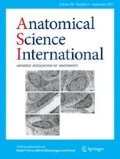Abstract
Anatomy is the science and art of understanding the structure of the body and its components in relation to the functions of the whole-body system. Medicine is based on a deep understanding of anatomy, but quite a few introductory-level learners are overwhelmed by the sheer amount of anatomical terminology that must be understood, so they regard anatomy as a dull and dense subject. To help them learn anatomical terms in a more contextual way, we started a new open-source project, the Network of Anatomical Texts (NAnaTex), which visualizes relationships of body components by integrating text-based anatomical information using Cytoscape, a network visualization software platform. Here, we present a network of bones and muscles produced from literature descriptions. As this network is primarily text-based and does not require any programming knowledge, it is easy to implement new functions or provide extra information by making changes to the original text files. To facilitate collaborations, we deposited the source code files for the network into the GitHub repository (https://github.com/ryusukemomota/nanatex) so that anybody can participate in the evolution of the network and use it for their own non-profit purposes. This project should help not only introductory-level learners but also professional medical practitioners, who could use it as a quick reference.



Similar content being viewed by others
References
Assenov Y, Ramirez F, Schelhorn S-E, Lengauer T, Albrecht M (2008) Computing topological parameters of biological networks. Bioinformatics 24:282–284
Bader G, McCalman M, Gibbons D (2017) Wine and cheese. http://www.wineandcheesemap.com. Accessed 14 Feb 2017
Chen S, Jiang H, Cao Y et al (2016) Drug target identification using network analysis: taking active components in Sini decoction as an example. Sci Rep 6:24245. doi:10.1038/srep24245
Diogo R, Esteve-Altava B, Smith C, Boughner JC, Rasskin-Gutman D (2015) Anatomical network comparison of human upper and lower, newborn and adult, and normal and abnormal limbs, with notes on development, pathology and limb serial homology vs. homoplasy. PLoS One 10:e0140030
Esteve-Altava B, Diogo R, Smith C, Boughner JC, Rasskin-Gutman D (2015) Anatomical networks reveal the musculoskeletal modularity of the human head. Sci Rep 5:8298. doi:10.1038/srep08298 (Published online: 6 February 2015)
Manrique P, Cao Z, Gabriel A et al (2016) Women’s connectivity in extreme networks. Sci Adv 2:e1501742
Ong E, Xiang Z, Zhao B et al (2017) Ontobee: a linked ontology data server to support ontology term dereferencing, linkage, query and integration. Nucleic Acids Res 45:D347–D352
Ono K (2016) Technical aspects of Panama Papers analysis. Newsweek Japan 12 April 2016
Rosse C, Mejino JV (2003) A reference ontology for biomedical informatics: the Foundational Model of Anatomy. J Biomed Inf 36:478–500
Shannon P, Markiel A, Ozier O et al (2003) Cytoscape: a software environment for integrated models of biomolecular interaction networks. Genome Res 13:2498–2504
Zhang B, Fu Y, Huang C et al (2016) New strategy for drug discovery by large-scale association analysis of molecular networks of different species. Sci Rep 6:21782
Acknowledgements
We are grateful to Professor Thomas R. Gest (Texas Tech University Health Sciences Center, Paul L. Foster School of Medicine) for allowing us to use the tables in our project. This work was supported by the Okayama Medical Foundation.
Author information
Authors and Affiliations
Corresponding author
Ethics declarations
Conflict of interest
The author declares no conflict of interest.
Electronic supplementary material
Below is the link to the electronic supplementary material.
Rights and permissions
About this article
Cite this article
Momota, R., Ohtsuka, A. Network of anatomical texts (NAnaTex), an open-source project for visualizing the interaction between anatomical terms. Anat Sci Int 93, 149–153 (2018). https://doi.org/10.1007/s12565-017-0410-1
Received:
Accepted:
Published:
Issue Date:
DOI: https://doi.org/10.1007/s12565-017-0410-1




